Hack:
The Project Canvas - Magic Conversations for Interdiscisplinary Teams
Co-Authored By Karen Schmidt Karen Schmidt
April 22, 2016 at 7:32am
Moonshots
Summary
Hack the way we start projects. Be yourself, be human, ask powerful questions and benefit from interdisciplinary wisdom.
Problem
Projects, just as games, are out of the ordinary.
Projects are temporary sidesteps from daily obligations, routines, and structures. Projects as well as games ask for a special arrangement of time, space, participants, and rules. This special arrangement requires the commitment of all participants. If people don’t like their playground, if they don’t accept or understand the rules of play, the desired action cannot take place (or it won't be fun at all).
The main challenge is, that projects bring people together who typically don't join forces. Consequently, the individual views concerning the project are very different. This is normal at the beginning of every complex project. It's not because some people are "wrong or right"; it's just because of diverse professional and cultural perspectives and divergent states of information. It is because, "we all live in different worlds" (Schopenhauer) and "the limits of our language mean the limits of our worlds" (Wittgenstein).
One of the greatest traps in projects is the illusion, that people think alike. Of course assuming this is always a problem, but in everday work we can learn to cope with it. Over weeks and months and years, we get used to our colleagues and figure out how they tick; we can experiment, practice, and eventually develop routines. In projects, we don't have this time!
Solution
The Project Canvas simply is "a sheet of paper, that serves as an invitation to talk". It may sound funny, but it's true! More than anything, the Project Canvas is an excuse to break away from daily routines and take the time to talk about a project.
Everybody can observe the magic that happens, when people gather around their project canvas. This magic is created by what Yves Pigneur and Alexander Osterwalder call the "design attitude". For some people, particularly in big organizations, the design attitude is the exact opposite of the linear decision-oriented approach they are used to. Having a design attitude means taking time for open-minded and non-linear analysis and exploration.
Since the project canvas provides guidance too, this exploration is neither chaotic nor undirected. Quite the contrary, it's clear and systematic. But the Project Canvas does not provide a strict instruction. It offers room for each team to find their own way. This is another ingredient of the magic: when applying the Project Canvas people discuss, discover, develop and through this find a common ground.
And here is how the Project Canvas creates magic conversations:
-
Common Metaphor: What is actually "a project"? We asked more than 3,000 persons, from more than 50 professions and all continents, "how would you explain what a project is to a twelve-year-old?". Most people replied a "journey into the unknown". We visualized this journey and made it the basis of conversation.
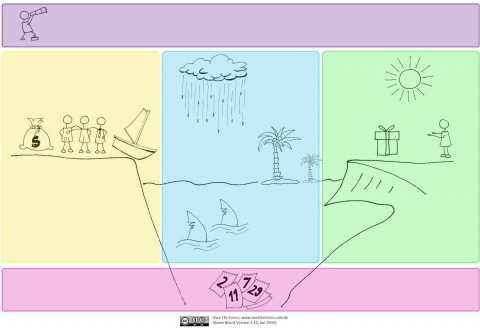
-
Simple Structure: Just the main eleven building blocks that describe any project: Team, Budget, Resources ("input"), Customer, Result, Quality ("output"), Context, Risks/Chances, Milestones ("transformation"), Time, and the Purpose of the project.

- Natural Language: Over three years, we aimed at shaping the language of the Project Canvas. We sorted out all terms that appeared to be specific for a particular profession, e.g. "user" (for IT), "scope" and "stakeholder" (for PM).
- Powerful Questions: During the same time, we searched for crucial "design questions" that help to map out any project. An amazing crowd of international people helped to co-create and shape these questions. The result is a deck of question cards which can be used to guide your project canvas session.
- Open Approach: The Project Canvas is applicable in agile projects (Scrum, etc.) as well as in traditional settings (Prince2, etc.).
- Compliant to PM Standards: Despite it's simple structure, the Project Canvas is in accordance with PMBoK Guide, PM3, DIN 69901, ISO 21500, and other standards. Therefore, project professionals can use the canvas to make "PM terminology" understandable for non-project professionals.
Practical Impact
When you apply the Project Canvas, you facilitate communication and create a sketch of your project. This sketch offers two main benefits: (a) it is a common ground, and (b) it quickly reveals those parts of your project, which are in need of further consideration (i.e. it identifies the known-unknowns). In addition, applying the project canvas provides a great experience in team building.
You can apply the Project Canvas whenever you need to design a project. This could happen due to various reasons and during various project stages.
Most commonly, the Project Canvas is applied for ...
- Project IDEA Design: Many people have great ideas. But often, an idea is not enough to start an ambitious project. Usually, you want to think through your idea and map out related constraints and impacts, before you kick-off your venture. By means of the Project Canvas and a set of powerful questions, you can develop and visualize your first holistic picture of the project. This result is helpful to gain confidence, supporters and sponsors, and enter the next stage.
- Project PROPOSAL Design: Bigger projects need a sound preparation. The stage between the idea sketch and the actual start of the project is called "project description", "feasibility study", or "business case analysis". Not rarely, this stage is so comprehensive that it becomes an own project, a so-called "pre-project". The main result of such a pre-project is the "Project Design". Based on the mapped out Project Canvas, further project documents (like a Project Charter, etc) can be issued, and the project can start.
Challenges
The Project Canvas is typically applied in workshop-like sessions. Effective workshop formats are as diverse as organizations and people, communication styles and cultures. The biggest challenge is to find an appropriate workshop format for your setting. For this, consider the following parameters:
- Type of group: project core team or with further stakeholders (customers, etc.)
- Number of persons: from very small teams to very big groups of 20 persons or more
- Way of facilitation: guided by an experienced facilitator or self-organized
- Duration: from one hour to a couple of days (in case of large-scale projects)
- Space of encounter: on-site or online
First Steps
If you want to organize a Project Canvas workshop:
- Download the Project Canvas from the "Over the Fence" website (for free).
- Follow the handy tips given there.
- Respect the Creative Commons licence.
- Utilize the tool for your purposes.
- Have fun and great projects!
Credits
We are not claiming to be project management gurus. More than anything, we are listeners, observers and explorers. If you like this hack, it's due to the brilliant people we had the pleasure to meet. These people come from very different fields – sports, arts, crafts, engineering, education, sciences, civial society and business – and they all share a great passion for what they are doing.
We wish to thank the "Over the Fence" community!
Materials



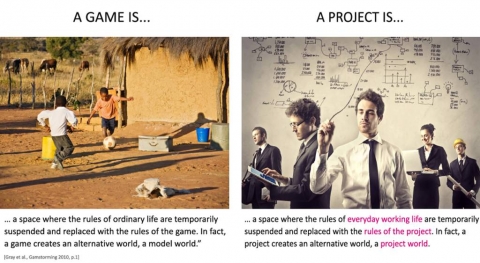
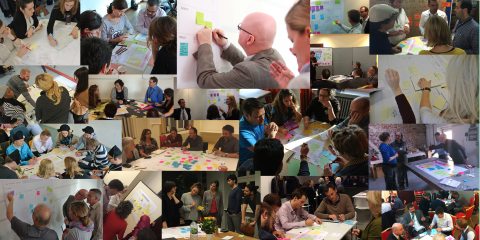
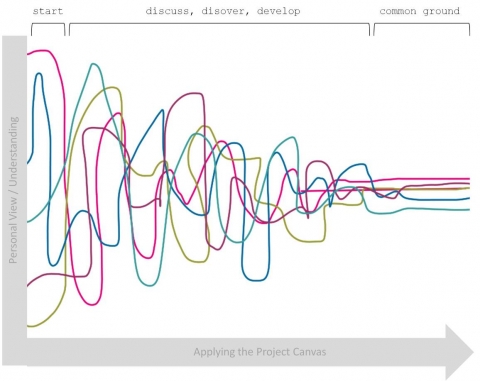
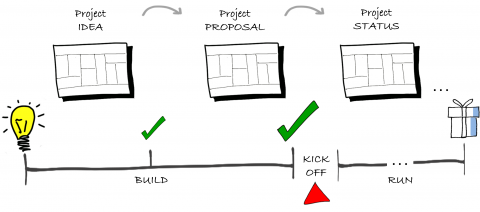
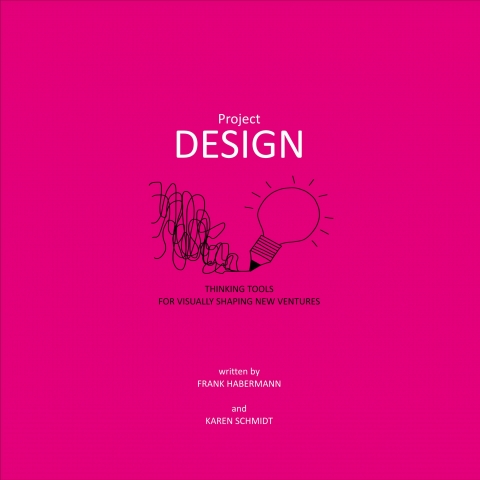
You need to register in order to submit a comment.